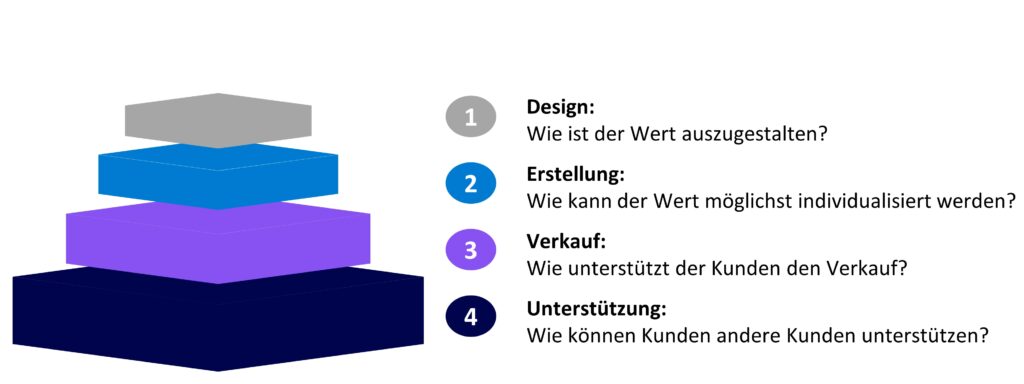Service-Dominant Logic has introduced the concept of co-creation or customer engagement. Service-Dominant Logic assumes that the customer is always a component of an organization’s value creation. In recent years, the possibilities for controlling and integrating the customer into value creation have increased significantly. Therefore, a definition co-creation is important for the successful use of this model. So far, however, this perspective has hardly found its way into the literature. Organizations are mistakenly or truncatedly viewed as solely value-providing systems that provide value to customers who can obtain it through a transaction in exchange for money. If the value provided by the organization meets or exceeds the customer’s expectations, the customer is satisfied and the organization is therefore customer-centric. Above all, the wave of success of agile working has meant that aligning offerings with customer needs has already been misunderstood as customer-centric. This old-fashioned understanding can also be observed in many “modern” start-ups. Aligning offerings as closely as possible to customer needs not only makes sense, but also contributes to an organization’s ability to survive. Aligning offerings with customer needs is a necessary but not sufficient condition for an organization to be customer-centric. Thus, customer orientation does not only refer to innovation or offer management, but it is necessary to take a much broader perspective on the possibilities of value creation in the context of customer relationships. Since the 1990s, it has been concluded that customer integration (co-creation) is of central importance for the customer orientation of an organization. Customer-centric organizations, unlike non-customer-centric ones, therefore involve the customer in business model, brand, experience, and offering development, as well as for all other processes in the organization and its network. In this context, customer centricity is not simply aimed at integrating customers in the sense of relationship management. The aim is to integrate customers into the processes in such a way that value is systematically increased for the customers, but also for the organization.

Definition Co-Creation
Co-creation is a process in which the customer is involved as a resource in the creation of value. of an organization is integrated. There can be different degrees of interaction give
In principle, more and more customers are willing to contribute their own resources to the value creation of organizations. The definition of co-creation therefore also focuses on the process. One example is the development of the open source movement. B2B industries have been working together in this way for years. Suppliers usually work with their customers on new solutions for several years. Co-creation is now also increasingly used in B2C industries. Technological developments have given a new boost to this form of interaction between customers and organizations. Co-creation is not without risk, especially when it is not really clear what value is to be created. So it’s exciting to see organizations providing more and more touchpoints and processes to co-create with the customer. A clear objective is rarely to be discovered. In the simplest case, this can result in no value being created or no return on investment for the organization. But it’s entirely possible that this aimless approach could also cause harm to the organization if customers, enabled by the organizations, can express themselves negatively on their own platforms. Thus, as is always the case in management, a clear system of objectives and a clear strategy is required as to how, where and to what extent co-creation is to be pursued. Value creation and control options for the organization must be considered. Three dimensions of co-creation are generally distinguished so far. The use of customer insights, for example. based on customer surveys is to be regarded as a kind of co-creation. Other organizations use customers in co-creation workshops to develop business models, brands, customer experiences and offerings. Still other organizations let customers create the quote (e.g., Wikipedia). So far, the use of co-creation for sales has been completely underestimated. Some organizations, such as Swisscom, have recognized the added value of co-creation and are using it consistently. More and more offerings have a modular structure and/or are surrounded by a ring of value-added services. Not every customer wants or needs all the services. Swisscom has established a co-creation process for sales in which, with the help of the customer’s management, the respective offering is defined jointly in workshops. In addition, organizations make user groups available to other customers as an aid to offer usage.
Few organizations have yet set themselves the goal of creating more in-depth value with their customers. The first step is to establish the definition of co-creation throughout the entire company. This underscores the statement that most managers do not realize that customer centricity today goes far beyond customer satisfaction. In addition to continuous transformation, customer centricity essentially aims to integrate the customer into value creation in the most value-creating way possible. In doing so, each individual organization has different capabilities. In addition to the fundamental appreciation of customers, they should be integrated as optimally as possible into the value creation process (co-creation).
Co-creation can be viewed from the perspective of the customer or the organization. It should be understood not only as the integration of the customer into the service delivery process of an organization, but also as the integration of the organization into the life of the customer. Value is defined from the organization’s perspective as customer value and value from the customer’s perspective as net customer benefit. An organization can only provide value. The customer is always the real creator of value. Value creation, like the other elements of customer management, is furthermore composed of planned as well as emergent activities. For this reason, it is important to note the close connection between co-creation and customer experience management. An organization can try to design the respective experiences through specifications, but due to the unplannable influence of the customer, the experiences will always have a different value outcome.
Co-creation is distinguished at four levels:
- Customers can assist the organization regarding the design of value delivery.
- In addition, they can provide a greater or lesser proportion of the value themselves.
- Referral as a form of co-creation in sales should also be considered.
- Organizations additionally use customers to help other customers use offerings.
In this context, the four stages are closely interconnected. A recommendation can include the sales aspect in the form of a simple purchase recommendation, but also the support aspect in the form of a detailed description of the use of the recommended offer. Co-creation is closely related to what point of reference the customer should have in the interaction. The following forms of interaction can be distinguished:
- Customer with himself
- Customer with other customers
- Customer with a theme
- Customer with the network of the organization
- Customer with the organization
It is mostly focused on the value creation between customer and organization. The remainder of this paper also focuses on this form of interaction. However, it is important to keep in mind that despite this chosen focus, the customer always interacts more or less with the entire network of an organization or with its ecosystem. This network perspective is an important element of the definition co-creation.
Our offer in the field of customer orientation Consulting
Kundenorientierung ist in aller Munde. Dabei reicht es nicht aus, begeisternde bzw. möglichst einfache Erlebnisse zu definieren. Es gilt, die Anpassungsfähigkeit des Unternehmens an Veränderungen im Einkaufsverhalten der Kunden sicherzustellen. Als spezialisierte Beratung Kundenorientierung verfügen wir über Tools und Erfahrungen, Dich bei Deiner Transformation zur Verbesserung der Kundenorientierung erfolgreich zu unterstützen.
Das Buch zum Thema
The topic of co-creation is presented comprehensively in the book Customer Centricity starting on page 363. Practical examples are also provided and additional recommendations are made for the individual levels. A deeper understanding about co-creation is worthwhile.





